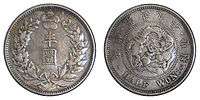Silver Dragon (coin)



Silver Dragon coins, also sometimes known as Dragon dollars, are silver coins issued by China, Japan and later Korea for general circulation in their own countries. Featuring a dragon on the obverse, all were inspired by the silver Spanish dollar which following its introduction into the region in the 16th Century had set the standard for a de facto common currency for trade in the Far East, this specification being a weight of 27.22 grams and a fineness of .900.
History
Following the establishment of the Spanish Philippines, Intramuros became an entrepôt for Chinese goods in one direction and silver, from across the Pacific to the Spanish held silver mines of Mexico, in the other. This so-called "Manila Galleons" trade route, led from the 16th Century onwards to the wide circulation and acceptance of "pieces of eight" in East Asia. Even after the end of the Spanish Empire in the Americas, Western nations wishing to trade with China found the preferred method of payment was the silver Mexican Peso, the successor of the Spanish dollar.
The high regard in which the Spanish-Mexican coins came to be held, led to the minting of silver Chinese yuan, Japanese yen and later Korean won coins to the same specifications as the Spanish ones i.e. a weight 7 mace and 2 candareens (approx. 27.22 grams or 420 grains) and a fineness of .900 (90%), for use as legal tender in their own countries. The name of these coins in all three countries derives from 圓, meaning round or circular object in all three languages, a link to these silver coins surviving in the modern names of the Chinese, Japanese and North and South Korean currencies, that is yuan, yen, and won.
These coins were joined in circulation by trade dollars and colonial currencies such as the Hong Kong dollar and the Straits dollar, which were produced to the same standard. Japan too would produce a trade dollar for external use which differed slightly from the yen coins it issued for its own use at home. The common standard to which all these coins were produced facilitated trade as theoretically they were interchangeable with one another on a one for one basis. However this was moderated by the fact that the general population were suspicious of coins that they were not familiar with and with some of the provincial mints in China producing debased coins; having a lower silver content and therefore less valuable because of it.
China
Chinese coins of this type are known Kwangtung dollars from the old romanisation of the name of the mint that they were first produced in China, more popularly they are known in Chinese as 龍銀, literally "Dragon Silver" or "Dragon Money", 銀 capable of being read as both silver or money.
Even before the official ending of the Qing dynasty factions and cliques emerged as would be warlords jostled for position and influence. As China headed into the republican and warlord eras, local warlords used the provincial mints to issue their own Silver Dragons, these are of variable quality and value depending on the greed and resources of the warlord in question. These warlord and pre-warlord era coins include high quality coins intended to promote the legitimacy and prestige of the warlord and his faction and are proudly marked as such; there are also low quality coins, the majority, intended to deceive the receiver into believing that they are earlier coins of higher silver content and value, though not fake-in so much that they came from semi-official sources-these were and are of variable value depending on their silver content. With the coming of the Chinese republic China would continue producing silver coins of the same specification updated to bear the image of Yuan Shikai and other politicians. China was forced from the silver standard in 1935, however even after the silver coins became demonetised they remained a highly prized means of preserving wealth in an era of inflation and war.
Legacy
The first Chinese Silver Panda collectable silver bullion coins were of the traditional specification of 27grams in weight, 0.900 fineness.
Collecting
Collecting silver dragon coins especially Chinese ones can be a financially hazardous prospect, with even experienced experts falling foul of fakes. There are modern fakes of genuine coins, historical fakes of genuine coins, and today given that some of the historical fakes have gained a numismatic value of their own, modern fakes of historical fakes.
External links
- History of the Silver Yen Japanese
- The Meiji Period Yen Japanese
- Varieties and History of the late Qing dynasty Chinese Silver Coins English